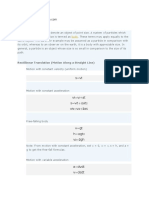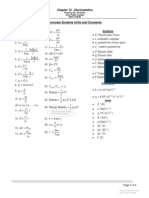Projectile Motion
Projectile Motion
Uploaded by
Alvin Tung Kwong ChoongCopyright:
Available Formats
Projectile Motion
Projectile Motion
Uploaded by
Alvin Tung Kwong ChoongOriginal Description:
Copyright
Available Formats
Share this document
Did you find this document useful?
Is this content inappropriate?
Copyright:
Available Formats
Projectile Motion
Projectile Motion
Uploaded by
Alvin Tung Kwong ChoongCopyright:
Available Formats
Projectile Motion
Lecture 4
Dr. Tamer A. Tabet
ENGINEERING MATHEMATICS II
Dr. Tamer A. Tabet
Course Code: KT00503
SEMS -2- 2012/2013, Wedn. 19/03/2013
Venue: DKP 3
Time: 8.00 10.00 AM.
Lecture 5
PROJECTILE MOTION
MATH II
University Malaysia Sabah
Dr. Tamer A. Tabet
2013
Part 1.
Summary
Part 2.
Introduction
Projectile Motion:
Motion through the air without a propulsion
Examples:
Part 1.
Motion of Objects Projected
Horizontally
v
0
x
y
x
y
x
y
x
y
x
y
x
y
Motion is accelerated
Acceleration is constant,
and downward
a = g = -9.81m/s
2
The horizontal (x)
component of velocity is
constant
The horizontal and vertical
motions are independent of
each other, but they have a
common time
g = -9.81m/s
2
ANALYSIS OF MOTION
ASSUMPTIONS:
x-direction (horizontal): uniform motion
y-direction (vertical): accelerated motion
no air resistance
QUESTIONS:
What is the trajectory?
What is the total time of the motion?
What is the horizontal range?
What is the final velocity?
x
y
0
Frame of reference:
h
v
0
Equations of motion:
X
Uniform m.
Y
Accel. m.
ACCL. a
x
= 0 a
y
= g = -9.81
m/s
2
VELC. v
x
= v
0
v
y
= g t
DSPL. x = v
0
t y = h + g t
2
g
Trajectory
x = v
0
t
y = h + g t
2
Eliminate time, t
t = x/v
0
y = h + g (x/v
0
)
2
y = h + (g/v
0
2
) x
2
y = (g/v
0
2
) x
2
+ h
y
x
h
Parabola, open down
v
01
v
02
> v
01
Total Time, t
y = h + g t
2
final y = 0
y
x
h
t
i
=0
t
f
=t
0 = h + g (t)
2
Solve for t:
t = 2h/(-g)
t = 2h/(9.81ms
-2
)
Total time of motion depends
only on the initial height, h
t = t
f
- t
i
Horizontal Range, x
final y = 0, time is
the total time t
y
x
h
t = 2h/(-g)
x = v
0
2h/(-g)
Horizontal range depends on the
initial height, h, and the initial
velocity, v
0
x
x = v
0
t
x = v
0
t
VELOCITY
v
v
x
= v
0
v
y
= g t
v = v
x
2
+ v
y
2
= v
0
2
+g
2
t
2
tg = v
y
/ v
x
= g t / v
0
FINAL VELOCITY
v
v
x
= v
0
v
y
= g t
v = v
x
2
+ v
y
2
v = v
0
2
+g
2
(2h /(-g))
v = v
0
2
+ 2h(-g)
tg = g t / v
0
= -(-g)2h/(-g) / v
0
= -2h(-g) / v
0
is negative
(below the
horizontal line)
t = 2h/(-g)
HORIZONTAL THROW - Summary
Trajectory Half -parabola, open
down
Total time
t = 2h/(-g)
Horizontal Range
x = v
0
2h/(-g)
Final Velocity
v = v
0
2
+ 2h(-g)
tg = -2h(-g) / v
0
h initial height, v
0
initial horizontal velocity, g = -9.81m/s
2
Part 2.
Motion of objects projected at an
angle
v
i
x
y
v
ix
v
iy
Initial velocity: vi = v
i
[]
Velocity components:
x- direction : v
ix
= v
i
cos
y- direction : v
iy
= v
i
sin
Initial position: x = 0, y = 0
x
y
Motion is accelerated
Acceleration is constant, and
downward
a = g = -9.81m/s
2
The horizontal (x) component of
velocity is constant
The horizontal and vertical
motions are independent of each
other, but they have a common
time
a = g =
- 9.81m/s
2
ANALYSIS OF MOTION:
ASSUMPTIONS
x-direction (horizontal): uniform motion
y-direction (vertical): accelerated motion
no air resistance
QUESTIONS
What is the trajectory?
What is the total time of the motion?
What is the horizontal range?
What is the maximum height?
What is the final velocity?
Equations of motion:
X
Uniform motion
Y
Accelerated motion
ACCELERATION
a
x
= 0 a
y
= g = -9.81 m/s
2
VELOCITY
v
x
= v
ix
= v
i
cos
v
x
= v
i
cos
v
y
= v
iy
+ g t
v
y
= v
i
sin + g t
DISPLACEMENT
x = v
ix
t = v
i
t cos
x = v
i
t cos
y = h + v
iy
t + g t
2
y = v
i
t
sin + g t
2
Equations of motion:
X
Uniform motion
Y
Accelerated motion
ACCELERATION
a
x
= 0 a
y
= g = -9.81 m/s
2
VELOCITY
v
x
= v
i
cos
v
y
= v
i
sin + g t
DISPLACEMENT
x = v
i
t cos y = v
i
t
sin + g t
2
Trajectory
x = v
i
t cos
y = v
i
t
sin + g t
2
Eliminate time, t
t = x/(v
i
cos )
y
x
Parabola, open down
2
2 2
2 2
2
cos 2
tan
cos 2 cos
sin
x
v
g
x y
v
gx
v
x v
y
i
i i
i
O
+ O =
O
+
O
O
=
y = bx + ax
2
Total Time, t
final height y = 0, after time interval t
0 = v
i
t
sin + g (t)
2
Solve for t:
y = v
i
t
sin + g t
2
0 = v
i
sin + g t
t =
2 v
i
sin
(-g)
t = 0 t
x
Horizontal Range, x
final y = 0, time is
the total time t
x = v
i
t cos
x = v
i
t cos
x
x
y
0
t =
2 v
i
sin
(-g)
x =
2v
i
2
sin cos
(-g)
x =
v
i
2
sin (2
)
(-g)
sin (2
) = 2 sin cos
Horizontal Range, x
x =
v
i
2
sin (2
)
(-g)
(deg) sin (2
)
0 0.00
15 0.50
30 0.87
45 1.00
60 0.87
75 0.50
90 0
CONCLUSIONS:
Horizontal range is greatest for the
throw angle of 45
0
Horizontal ranges are the same for
angles and (90
0
)
Trajectory and horizontal range
2
2 2
cos 2
tan x
v
g
x y
i
O
+ O =
0
5
10
15
20
25
30
35
0 20 40 60 80
15 deg
30 deg
45 deg
60 deg
75 deg
v
i
= 25 m/s
Velocity
Final speed = initial speed (conservation of energy)
Impact angle = - launch angle (symmetry of parabola)
Maximum Height
v
y
= v
i
sin + g t
y = v
i
t
sin + g t
2
At maximum height v
y
= 0
0 = v
i
sin + g t
up
t
up
=
v
i
sin
(-g)
t
up
= t/2
h
max
= v
i
t
up
sin + g t
up
2
h
max
= v
i
2
sin
2
/(-g) + g(v
i
2
sin
2
)/g
2
h
max
=
v
i
2
sin
2
2(-g)
Projectile Motion Final Equations
Trajectory
Parabola, open down
Total time
t =
Horizontal range
x =
Max height
h
max
=
(0,0) initial position, v
i
= v
i
[] initial velocity, g = -9.81m/s
2
2 v
i
sin
(-g)
v
i
2
sin (2
)
(-g)
v
i
2
sin
2
2(-g)
Forces in Two Dimensions
Force is also represented in x-y components.
Finding the total velocity
Use the pythagorean theorem to find the
resultant velocity using the components (V
x
and V
y
)
Use SOH CAH TOA to find the direction
Vx
V
y
V
Example 2
A cat chases a mouse across a 1.0 m high
table. The mouse steps out of the way and the
cat slides off the table and strikes the floor 2.2
m from the edge of the table. What was the
cats speed when it slid off the table?
What do we know and what are we looking for?
x= 2.2 m
y= -1.0m (bc the cat falls down)
2.2m
1
.
0
m
Vx= ?????
What are we looking for??
How do we find Vx?
Equation for horizontal motion:
We have xso we need t.
How do we find how long it takes for the cat to hit the
ground?
Use the vertical motion kinematic equations.
t v x
x
=
Vertical Motion
y= -1.0m
a=-9.81 m/s^2
What equation should we use?
Rearrange the equation, to solve for t then plug in
values.
2
2
1
at y = A
s
s
m
m
a
y
t 45 .
81 . 9
) 0 . 1 ( 2 2
2
=
= =
Horizontal equation
Rearrange and solve for
Vx:
Cats Speed is 4.89 m/s
s
m
s
m
t
x
v
x
89 . 4
45 .
2 . 2
= = =
t v x
x
=
Cliff example
A boulder rolls off of a cliff and lands 6.39
seconds later 68 m from the base of the cliff.
What is the height of the cliff?
What is the initial velocity of the boulder?
How high is the cliff?
y= ? a=-9.81 m/s
2
t = 6.39 s V
x
=?
V
y,i
= 0 x= 68 m
2
2
1
at y =
m
s
m
at y 200 ) 39 . 6 )( 81 . 9 (
2
1
2
1
2
2
2
= = =
The cliff is 200 m high
What is the initial velocity of the boulder?
The boulder rolls off the cliff horizontally
Therefore, we are looking for Vx
t v x
x
=
s
m
s
m
t
x
v
x
6 . 10
39 . 6
68
+ = = =
Important Concepts for Projectiles Launched
Horizontally
Horizontal Components Vertical Components
Horizontal Velocity is
constant throughout the
flight
Horizontal acceleration is
0
Initial vertical velocity is 0
but increases throughout
the flight
Vertical acceleration is
constant: -9.81 m/s
2
Projectiles Launched at An Angle
Projectiles Launched
Horizontally
Projectiles Launched at
an Angle
V
x
is constant
Initial V
y
is 0
V
x
is constant
Initial V
y
is not 0
V
i
V
x,i
V
y,i
V
i
= V
x
Components of Initial Velocity for Projectiles
Launched at an angle
Use soh cah toa to find the V
x,i
and V
y,i
i
i x
v
v
h
a
,
) cos( = = u
( )
i
i y
v
v
h
o
,
sin = = u
( ) u cos
, i i x
v v =
V
i
V
x,i
V
y,i
( ) u sin
, i i y
v v =
Revise the kinematic equations again
Horizontal Motion Vertical Motion
( ) ( )
2
2
1
sin t a t v y
i
A + A = A u
( ) u cos
, i i x x
v v v = =
( ) t v t v x
i x
A = A = A u cos
y a v y a v v
i i y f y
A + = A + = 2 )) sin( ( 2
2 2
,
2
,
u
( ) at v at v v
i i y f y
+ = + = u sin
, ,
What do we know?
x= 42.0 m
= 25
V
i
= 23.0 m/s
V
y
at top = 0
t=?
y=?
42.0 m
25
What can we use to solve the problem?
Find t using the horizontal eqn:
x=v
x
t = v
i
cos()t
How to find y?
V
y,f
= 0 at top of the balls path
What equation should we use?
y a v v
i y f y
A + = 2
2
,
2
,
( )
( )
s
s
m
m
v
x
v
x
t
i x
0 . 2
25 )(cos 23 (
0 . 42
cos
= =
A
=
A
= A
u
( )
( )
m
s
m
s
m
a
v
a
v v
y
i
i y f y
8 . 4
81 . 9 2
25 sin ) 23 ( 0
2
) sin ( 0
2
2
2
2
2
,
2
,
=
|
.
|
\
|
|
.
|
\
|
= A
u
Cliff example
A girl throws a tennis ball at an angle of 60North of East from
a height of 2.0 m. The balls range is 90 m and it is in flight for
6 seconds.
What is the initial horizontal velocity of the ball?
What is the initial vertical velocity of the ball?
What is the total initial velocity of the ball?
How high above the initial position does the ball get?
What is the vertical velocity of the ball 2 seconds after it is thrown?
What is the initial horizontal velocity of the ball?
x= 90 m
=60
Total time= 6 s
Horizontal velocity is
constant: Vx
t v x
x
=
East 15
6
90
s
m
t
x
V
x
= = =
What is the initial vertical velocity of the ball?
i Vx
i Vy
,
,
tan = u
North 26 98 . 25 ) 15 )( 60 tan(
,
s
m
s
m
V
i y
= = =
Vx,i
Vy,i
Vi
What is the total initial velocity of the ball?
2
,
2
,
2
i y i x i
V V V + =
East of North 60 at 30 26 15
2 2
= + =
s
m
V
i
Vx,i
Vy,i
Vi
How high above the ground does the ball get?
At the top of the parabola, Vy
is 0so use the revised
kinematic equations
Add 2m to get the height
above the ground: 36.65 m
y a v v
i y f y
A + = 2
2
,
2
,
( )
m
s
m a
v v
y
i y f y
45 . 34
81 . 9 2
26 0
2
2
2
2
,
2
,
=
|
.
|
\
|
= A
What is the vertical velocity of the ball 2
seconds after it is thrown?
V
y,i
=+26 m/s
a= -9.81 m/s
2
t = 2 seconds
s
m
s
s
m
s
m
at v v
i y f y
4 . 6 ) 2 )( 81 . 9 ( 26
2
, ,
+ = + = + =
Important Concepts for Projectiles Launched at
an Angle
At the top of the parabola, neither the objects
velocity nor its acceleration is 0!!!!!
Only V
y
is 0
V
x
is constant throughout the flight
Horizontal acceleration is always 0
Vertical acceleration is always -9.81 m/s
2
QUESTIONS FOR
DISCUSSION
Projectile Motion Example
Q1:
Let's say you're on top of a cliff, which drops vertically 150 m to
the ocean below. You throw a ball with an initial speed of 8.40
m/s at an angle of 20 degrees above the horizontal
(a) How long does it take before it hits the water?
(b) How far is it from the base of the cliff to the point of impact?
As usual, be as systematic as possible. Draw a diagram, choose
a coordinate system, and organize your data.
X info. y info.
Initial
position
x
o
= 0 y
o
= +150 m
Final
position
x = ? y = 0
Initial
velocity
v
ox
= +v
o
cos(q)
= +7.893 m/s
v
oy
= +v
o
sin(q)
= +2.873 m/s
Acceler
ation
a
x
= 0 a
y
= -9.8 m/s
2
(a) How long does it take before it hits the water?
Use the y-information to find the time of flight. One method
is to do it in two steps, first calculating the final y-velocity
using the equation:
v
y
2
= v
oy
2
+ 2 a
y
(y - y
o
)
This gives v
y
2
= 2.873
2
+ 2 (-9.8) (-150) =
2948.3 m
2
/ s
2
.
Taking the square root gives: v
y
= +/- 54.30
m/s.
Remember that the square root can be positive or negative. In
this case it's negative, because the y-component of the velocity
will be directed down when the ball hits the ground.
Now find the time using:
v
y
= v
oy
+ a
y
t
So, -54.30 = 2.873 - 9.8 t, which gives t = 5.834 seconds.
Rounding off, the ball was in the air for 5.83 s.
b) How far is it from the base of the cliff to the point of
impact?
Plug the time we just calculated into the equation:
x - x
o
= v
ox
t + a
x
t
2
x = (7.893) (5.834) = 46.0 m.
Problem 2:
The formula h (t) = -16 t
2
+ 32 t + 80 gives the height h above
ground, in feet, of an object thrown, at t = 0, straight upward from
the top of an 80 feet building.
a - What is the highest point reached by the object?
b - How long does it take the object to reach its highest point?
c - After how many seconds does the object hit the ground?
d - For how many seconds is the height of the object higher than 90
feet?
Solution to Problem 2:
a - The height h given above is a quadratic function. The graph of h
as a function of time t gives a parabolic shape and the maximum
height h occur at the vertex of the parabola. For a quadratic function
of the form h = a t
2
+ b t + c, the vertex is located at t = - b / 2a.
Hence for h given above the vertex is at t
t = -32 / 2(-16) = 1 second.
1 second after the object was thrown, it reaches its highest point
(maximum value of h) which is given by
h = -16 (1)
2
+ 32 (1) + 80 = 96 feet
b - It takes 1 second for the object to reach it highest point.
c - At the ground h = 0, hence the solution of the equation h = 0
gives the time t at which the object hits the ground.
-16 t
2
+ 32 t + 80 = 0
The above quadratic equation has two solutions one is negative and
the second one is positive and approximately equal to 3.5 seconds.
So it takes 3.5 seconds for the object to hit the ground after it has
been thrown upward. The graphical meanings to the answers to
parts a, b and c can be shown.
d - The object is higher than 90 feet for all values of t satisfying the inequality
h > 90. Hence
-16 t
2
+ 32 t + 80 > 90
The above inequality is satisfied for
0.4 < t < 1.6 (seconds)
The height of the object is higher than 90 feet for
1.6 - 0.4 = 1.2 seconds.
The graph below is that of h in terms of t and clearly shows that h is greater
than 90 feet for t between 0.4 and 1.6 seconds.
Question 3
If you toss a ball upward in a train moving at constant speed, it
returns to its starting place. Will the ball do the same if the
train is accelerating?
A. Yes
B. No
Question 1 Answer
If you toss a ball upward in a train moving at
constant speed, it returns to its starting place.
Will the ball do the same if the train is
accelerating?
A. Yes
B. No
Question 2
When a rifle is being aimed at a distant target,
the barrel should be lined up so that it
points
A. Slightly higher than the target
B. Exactly at the target
C. Slightly lower than the target
Question 2 Answer
When a rifle is being aimed at a distant target,
the barrel should be lined up so that it points
A. Slightly higher than the target
B. Exactly at the target
C. Slightly lower than the target
ASSIGNMENT 1
SUBMISSION: DUE 5
th
of April
Lets look at an example:
Q1. A football is kicked from the ground to a position downfield. If
the ball is kicked with a speed of 20 m/s at a 45 degree angle, how
long will it be in the air? How far will the ball travel?
Q2) A bullet has a speed of 350 m/sec as it leaves a rifle. If it is
fired horizontally from a cliff 6.4 m above a lake, how far does the
bullet travel before striking the water?
Q3) A player kicks a football at an angle of 37
o
with the horizontal
and with an initial speed of 48 ft/sec. A second player standing at a
distance of 100 ft from the first in the direction of the kick starts
running to meet the ball at the instant it is kicked. How fast must he
run in order to catch the ball before it hits the ground?
Q4) A projectile shot at an angle of 60
o
above the horizontal
strikes a building 80 ft away at a point 48 ft above the point of
projection. (a) Find the initial velocity, (b) Find the magnitude
& direction of the velocity when it strikes the building.
PROJECTILE MOTION - SUMMARY
Projectile motion is motion with a constant
horizontal velocity combined with a constant
vertical acceleration
The projectile moves along a parabola
You might also like
- Dynamics of Rigid BodiesDocument74 pagesDynamics of Rigid BodiesArah Louise Apostol100% (1)
- Projectile MotionDocument32 pagesProjectile MotionSuresh100% (2)
- Kinematics by MathalinoDocument23 pagesKinematics by MathalinoJhill-Jhill Jimenez Dela Peña0% (1)
- Projectile Motion Guide For AP Physics 1Document27 pagesProjectile Motion Guide For AP Physics 1renenutet100% (2)
- AQA, Edexcel and OCR A-Level Maths - Revision GuideDocument18 pagesAQA, Edexcel and OCR A-Level Maths - Revision GuideAkash100% (1)
- Electrostatic FormulasDocument1 pageElectrostatic FormulasAli Dodhy60% (42)
- Projectile MotionDocument35 pagesProjectile Motionapi-285179261No ratings yet
- Today's Objectives: In-Class Activities:: Motion of A ProjectileDocument22 pagesToday's Objectives: In-Class Activities:: Motion of A ProjectileclinthopkinsNo ratings yet
- King Fahd University of Petroleum & MineralsDocument22 pagesKing Fahd University of Petroleum & MineralsTommyVercettiNo ratings yet
- NOTES - Projectile MotionDocument28 pagesNOTES - Projectile MotionAngelia SombreaNo ratings yet
- Universiti Tun Hussein Onn Malaysia: Mechanical Engineering Dynamics DDE2063 BY En. Khairulnizam Bin OthmanDocument22 pagesUniversiti Tun Hussein Onn Malaysia: Mechanical Engineering Dynamics DDE2063 BY En. Khairulnizam Bin OthmanKhairul HafizNo ratings yet
- Motion of A Projectile: Today's Objectives: In-Class ActivitiesDocument14 pagesMotion of A Projectile: Today's Objectives: In-Class ActivitiessohamdeyNo ratings yet
- MET 304 Engineering AnalysisDocument31 pagesMET 304 Engineering AnalysisOscar WangNo ratings yet
- Projectile Motion 12optDocument32 pagesProjectile Motion 12optKrish CvNo ratings yet
- Motion in Two or Three DimensionsDocument58 pagesMotion in Two or Three DimensionsMarc Howard Detera PanganibanNo ratings yet
- Projectile Motion Senior High School Physics: Lech Jedral 2006Document32 pagesProjectile Motion Senior High School Physics: Lech Jedral 2006kentNo ratings yet
- Projectile Motion STA 2012Document32 pagesProjectile Motion STA 2012KLINTH JERALD PINLACNo ratings yet
- ProjectileDocument40 pagesProjectileSweet EmmeNo ratings yet
- Projectile MotionDocument32 pagesProjectile MotionIdris Jeffrey MangueraNo ratings yet
- Projectile MotionDocument32 pagesProjectile MotionMae ThereseNo ratings yet
- Projectile Motion Senior High School Physics: Lech Jedral 2006Document32 pagesProjectile Motion Senior High School Physics: Lech Jedral 2006SureshNo ratings yet
- Projectile Motion 1Document32 pagesProjectile Motion 1apple llegadoNo ratings yet
- Lecture 4Document32 pagesLecture 4Asad SamiNo ratings yet
- Week 9 KinematicsDocument64 pagesWeek 9 Kinematicsiwhy_No ratings yet
- Projectile Motion: Physics Unit 5 Lesson 1Document18 pagesProjectile Motion: Physics Unit 5 Lesson 1Shivam KhemariyaNo ratings yet
- Projectiles in ADocument37 pagesProjectiles in AHiwetNo ratings yet
- Projectile Motion Senior High School Physics: Lech Jedral 2006Document32 pagesProjectile Motion Senior High School Physics: Lech Jedral 2006Ciara Adrianne Tiongzon - ReyesNo ratings yet
- 2022+Projectile+Motion+2022+Edited Converted Converted CompressedDocument89 pages2022+Projectile+Motion+2022+Edited Converted Converted CompressedAlthea Joy Castor SobretodoNo ratings yet
- CHAPTER 3 Giancoli: Physics Study Guide Dr. Lee: y V T - GTDocument3 pagesCHAPTER 3 Giancoli: Physics Study Guide Dr. Lee: y V T - GTheypartygirlNo ratings yet
- 1 Projectile Motion Lecture Tew 2013Document30 pages1 Projectile Motion Lecture Tew 2013api-202311099No ratings yet
- KinematicsDocument7 pagesKinematicsNicole WheelerNo ratings yet
- Lesson 1: Rectilinear Translation MotionDocument39 pagesLesson 1: Rectilinear Translation MotionAaron EserNo ratings yet
- MECHANICS PHYSICS A NOTES 1&2 Dim RevDocument14 pagesMECHANICS PHYSICS A NOTES 1&2 Dim Revokumuenock000No ratings yet
- Lecture 12Document37 pagesLecture 12Sarah Rachel100% (1)
- Lect 06Document13 pagesLect 06Dayang Feineliza Samman BahjinNo ratings yet
- Projectile Motion: Particular's Page NoDocument41 pagesProjectile Motion: Particular's Page NoRafsanjaniNo ratings yet
- Motion of A Projectile (Section 12.6) Today's Objectives: In-Class ActivitiesDocument15 pagesMotion of A Projectile (Section 12.6) Today's Objectives: In-Class ActivitiesbigbangmelvanNo ratings yet
- Kinematics: Previous Eamcet BitsDocument8 pagesKinematics: Previous Eamcet Bitsshahbazalam4a5No ratings yet
- CMCH 02Document19 pagesCMCH 02cychan410No ratings yet
- 2 +Kinematics+of+particles+-+Part+IIDocument43 pages2 +Kinematics+of+particles+-+Part+IIBEYZA ÇAVUŞOĞLUNo ratings yet
- Kinematics Acceleration Due To Free FallDocument23 pagesKinematics Acceleration Due To Free FallaugeroniiNo ratings yet
- Projectile MotionDocument72 pagesProjectile MotionYukiC1230% (1)
- Kinematics: Previous Eamcet BitsDocument8 pagesKinematics: Previous Eamcet BitsAnonymous 9uu04elNo ratings yet
- Chapter 2 KinematicDocument11 pagesChapter 2 KinematicTutor_KLNo ratings yet
- 143 First Assignment QuestionsDocument10 pages143 First Assignment QuestionsanyigbamarkmilbertNo ratings yet
- 557154756 Dynamics of Rigid BodiesDocument81 pages557154756 Dynamics of Rigid BodiesMicko C. RenomeronNo ratings yet
- Maths ProjectilesDocument12 pagesMaths Projectilesමේනුක සූවින්දNo ratings yet
- Definitions & Notes - Topic 2 Kinematics - CAIE Physics A-levelDocument5 pagesDefinitions & Notes - Topic 2 Kinematics - CAIE Physics A-levelliyuh1995No ratings yet
- Module 5: Advanced MechanicsDocument39 pagesModule 5: Advanced Mechanicsfinn22618No ratings yet
- Dynamics Lecture2 General Curvilinear Motion - Rectangular Components and Projectile MotionDocument41 pagesDynamics Lecture2 General Curvilinear Motion - Rectangular Components and Projectile MotionJJ Enzon100% (1)
- Lecture Notes For Section 12-6 PDFDocument8 pagesLecture Notes For Section 12-6 PDFgNo ratings yet
- Motion of A Projectile (Section 12.6) : Today's Objectives: In-Class ActivitiesDocument15 pagesMotion of A Projectile (Section 12.6) : Today's Objectives: In-Class ActivitiesRider TorqueNo ratings yet
- Chap4 PDFDocument22 pagesChap4 PDFMuzamil Shah50% (2)
- Projectile Motion at An AngleDocument25 pagesProjectile Motion at An AngleKenneth Kent Stinson FloresNo ratings yet
- LECTURE 06 (NOTE) - Module 04 - Motion in Two and Three DimensionsDocument8 pagesLECTURE 06 (NOTE) - Module 04 - Motion in Two and Three Dimensionszaki.farhanNo ratings yet
- Physics Kinematics in Two DimensionsDocument26 pagesPhysics Kinematics in Two DimensionsMeklitNo ratings yet
- Mechanics 2: November 2012Document31 pagesMechanics 2: November 2012Adnan FaisalNo ratings yet
- Chapter-2 - Kinematics of Linear MotionDocument27 pagesChapter-2 - Kinematics of Linear MotionSherena Peter GovindNo ratings yet
- Stem Guide June Update FinalDocument126 pagesStem Guide June Update FinaloppieloliiepNo ratings yet
- Transformation of Axes (Geometry) Mathematics Question BankFrom EverandTransformation of Axes (Geometry) Mathematics Question BankRating: 3 out of 5 stars3/5 (1)
- Budget ListDocument1 pageBudget ListAlvin Tung Kwong ChoongNo ratings yet
- CAE Past MidtermDocument3 pagesCAE Past MidtermAlvin Tung Kwong ChoongNo ratings yet
- Alvin Tung Kwong Choong: Specimengeometry01Document1 pageAlvin Tung Kwong Choong: Specimengeometry01Alvin Tung Kwong ChoongNo ratings yet
- KE30501 Lab 1 - Open and Close Loop SystemDocument24 pagesKE30501 Lab 1 - Open and Close Loop SystemAlvin Tung Kwong ChoongNo ratings yet
- Lithium-Ion Battery Safety: Detection of Developing Internal Shorts and Suppression of Thermal RunawayDocument4 pagesLithium-Ion Battery Safety: Detection of Developing Internal Shorts and Suppression of Thermal RunawayAlvin Tung Kwong ChoongNo ratings yet
- Causing So Much Emotion, Especially Pleasure, That It Cannot Be DescribedDocument1 pageCausing So Much Emotion, Especially Pleasure, That It Cannot Be DescribedAlvin Tung Kwong ChoongNo ratings yet
- Malaysia's Herbal Sector To Grow at 10 PCTDocument2 pagesMalaysia's Herbal Sector To Grow at 10 PCTAlvin Tung Kwong ChoongNo ratings yet
- Academic Reading and WritingDocument6 pagesAcademic Reading and WritingAlvin Tung Kwong ChoongNo ratings yet
- Growing Our Herbal IndustryDocument5 pagesGrowing Our Herbal IndustryAlvin Tung Kwong ChoongNo ratings yet
- Chapter 2 Example and Solution Block DiagramDocument5 pagesChapter 2 Example and Solution Block DiagramHiongyiiNo ratings yet
- Running Hours For Respective PumpDocument1 pageRunning Hours For Respective PumpAlvin Tung Kwong ChoongNo ratings yet
- Application of PantogaphDocument2 pagesApplication of PantogaphAlvin Tung Kwong ChoongNo ratings yet
- Sustainable ManufacturingDocument26 pagesSustainable ManufacturingAlvin Tung Kwong Choong0% (1)
- CEC 101 Structural MechanicsDocument175 pagesCEC 101 Structural Mechanicsolowonyo MuizNo ratings yet
- Ceklist - Monitoring - KPIDocument1,233 pagesCeklist - Monitoring - KPIRobyNo ratings yet
- Chapter-12 SoundDocument27 pagesChapter-12 SoundDevansh GuptaNo ratings yet
- 7th STD Maths General Assesment Practice Paper 2019-20 by Kps BidkalkatteDocument4 pages7th STD Maths General Assesment Practice Paper 2019-20 by Kps Bidkalkattegeethar301196No ratings yet
- National Science Day 2023 Article in English by Santosh TakaleDocument2 pagesNational Science Day 2023 Article in English by Santosh TakaleSantosh Takale100% (3)
- Application of IntegrationDocument36 pagesApplication of IntegrationNaman SharmaNo ratings yet
- EST TH 1 October 2018Document21 pagesEST TH 1 October 2018becy welbaNo ratings yet
- Digital Arc Voltage Height ControllerDocument58 pagesDigital Arc Voltage Height ControllerJosé I. Cárcamo S.No ratings yet
- 11.2 - Introduction To Particle Physics - Physics LibreTexts PDFDocument4 pages11.2 - Introduction To Particle Physics - Physics LibreTexts PDFpappuNo ratings yet
- Constant Head Permeability TestDocument12 pagesConstant Head Permeability Testanis098No ratings yet
- Charging of Nitrogen Gas Into AccumulatorDocument1 pageCharging of Nitrogen Gas Into AccumulatorConi Fuenzalida VarelaNo ratings yet
- CKT Unit-IIDocument32 pagesCKT Unit-IIPKNo ratings yet
- Ge 35 PSX: Use and Maintenance ManualDocument54 pagesGe 35 PSX: Use and Maintenance ManualTomaBogdanovNo ratings yet
- M20 Plate Heat ExchangerDocument47 pagesM20 Plate Heat ExchangerBimalka WeerasekaraNo ratings yet
- Weekly Assessment Test11ht-9Document8 pagesWeekly Assessment Test11ht-9helloshauryajainNo ratings yet
- Beverly 200 Fuses LightDocument7 pagesBeverly 200 Fuses LightviktormotoNo ratings yet
- Implicit Differentiation and ApplicationDocument22 pagesImplicit Differentiation and Applicationpagapongkyle.crshsNo ratings yet
- Anchor Bolt Design For Shear and TensionDocument2 pagesAnchor Bolt Design For Shear and TensiondragosbutcaNo ratings yet
- 3311071.017 DometicRooftopACMechanicalComfortSingleZoneControl SVM AMER (En) 2012 01Document63 pages3311071.017 DometicRooftopACMechanicalComfortSingleZoneControl SVM AMER (En) 2012 01Adrian LedesmaNo ratings yet
- Polyimide Foams For Aerospace VehiclesDocument12 pagesPolyimide Foams For Aerospace VehiclesLanceNo ratings yet
- Methodologies For The Seismic Design ofDocument12 pagesMethodologies For The Seismic Design ofgesap35224No ratings yet
- FulltextDocument126 pagesFulltextArab WeldersNo ratings yet
- Ehs 514 Env - Health Lab. Practice 11 2023Document20 pagesEhs 514 Env - Health Lab. Practice 11 2023jolenebakers0No ratings yet
- Instant Access to Essential Mathematics for Engineers and Scientists 1st Edition Pence ebook Full ChaptersDocument69 pagesInstant Access to Essential Mathematics for Engineers and Scientists 1st Edition Pence ebook Full Chapterspuriqiokeno100% (2)
- 1.1 Application: 1.2.1 Protection FunctionDocument20 pages1.1 Application: 1.2.1 Protection FunctionTý TrầnNo ratings yet
- Reflection Paper 2 - St. Thomas AquinasDocument4 pagesReflection Paper 2 - St. Thomas AquinasRandy MarshNo ratings yet
- Enthalpy and EntropyDocument26 pagesEnthalpy and EntropyLIEZEL ANNE ICALNo ratings yet
- 04 - SeAH Engineering - Torbo - EngDocument10 pages04 - SeAH Engineering - Torbo - Engвлад камр100% (1)






































































































